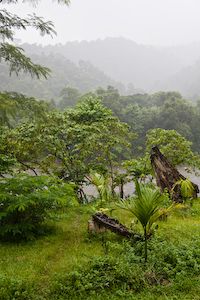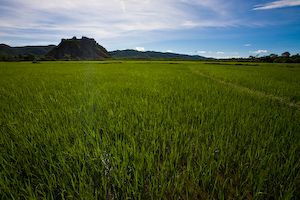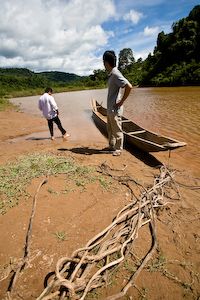It's late morning, hot, cicadas are buzzing at full throttle already. Water buffaloes are slowly making their way down into the river. Dogs are sleeping in the shade beneath the bamboo. We're well off the highway, having made our way in low gear down a steep rutted four wheel drive path, and we're now at the river which the locals call Ca Tang. We're about ten kilometers from the Laos border, and just north of the former DMZ – the demilitarized zone, the demarcation line created between north and south Vietnam during what the Vietnamese call The American War. As the epicenter of the country, Quang Binh and Quang Tri provinces were the most heavily bombed and deforested provinces during the war, so now are the poorest provinces.
We've come here with staff from a Vietnamese NGO, SPERI, Social Policy Ecological Research Institute. I told them that we've really come to Vietnam to get a first hand understanding of the cause of the so called "Asian food crisis", which has been ripping through the continent recently.
Rice is the staple food throughout Asia, and here in Vietnam the price of rice has doubled in the past year. Despite this, Vietnam has remained consistently the second largest exporter of rice in the world. Before leaving the U.S., seeing that export numbers have stayed so high made me think that perhaps Vietnam was not really impacted by this food crisis. Maybe they were one of the exceptions, and things were really doing ok.
But figures don't illustrate the facts, it turns out.
Tranh Thi Lanh, the Director of SPERI, emphasizes to me that out of a population of 87 million people in Vietnam, 10 million don't have enough rice to eat.
Although the central rice growing region is in the south, in the Mekong River delta, only a small fraction of the whole story can be understood there. Lanh emphasizes to me that the larger problem of the food crisis, as well as the answers to it, lies in the borderlands - in the marginal agricultural zones, where the mountains meet the lowlands, and where the Khin ethnic majority of Vietnam is thinned out or completely non-existent, predominantly the terrain of the people called the ethnic minorities.
So, we are about to get into a canoe, carved like a dugout. Steering the boat are two SPERI staff members, poling across with two bamboo poles. We get about half way when it becomes obvious that we are not going fast enough to avoid the rush of the current which is about to pull the boat down the rapids, so the one of the guys pulls his cell phone out of his pocket, dives into the river and pulls the boat the rest of the way across, wading through the current.
We're on our way to a small village inhabited by the Malieng people. The Vietnamese government offered to build the Malieng a bridge here, but they said they didn't want it, because with the bridge would come more people, and the Market. They would rather live without.





